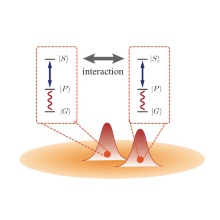Free-space quantum electrodynamics with a single Rydberg superatom
The interaction of a single photon with an individual two-level system is the textbook example of quantum electrodynamics. Achieving strong coupling in this system has so far required confinement of the light field inside resonators or waveguides. In this project, we demonstrated strong coherent coupling between a single Rydberg superatom, consisting of thousands of atoms behaving as a single two-level system because of the Rydberg blockade, and a propagating light pulse containing only a few photons. The strong lightmatter coupling, in combination with the direct access to the outgoing field, allowed us to observe, for the first time, the effect of the interactions on the driving field at the single-photon level. We found that all our results are in quantitative agreement with the predictions of the theory of a single two-level system strongly coupled to a single quantized propagating light mode.
- Free-space quantum electrodynamics with a single Rydberg superatom
A. Paris-Mandoki, C. Braun, J. Kumlin, C. Tresp, I. Mirgorodskiy, F. Christaller, H. P. Büchler, and S. Hofferberth, Phys. Rev. X 7, 041010 (2017)
Three-Body interaction of Rydberg slow-light polaritons
Within this project, we studied a system of three photons in an atomic medium coupled to Rydberg states near the conditions of electromagnetically induced transparency. Based on the analytical analysis of the microscopic set of equations in the far-detuned regime, the effective three-body interaction for these Rydberg polaritons was derived. Flor slow light polaritons, we found a strong three-body repulsion with the remarkable property that three polaritons can become essentially non-interacting at short distances. This analysis allowed us to derive the influence of the three-body repulsion on bound states and correlation functions of photons propagating through a one-dimensional atomic cloud.
- Three-body interaction of Rydberg slow-light polaritons
K. Jachymski, P. Bienias, and H. P. Büchler, Phys. Rev. Lett. 117, 053601 (2016)
Scattering resonances and bound states for strongly interacting Rydberg polaritons
In this project, we developed a theoretical framework describing slow-light polaritons interacting via atomic Rydberg states which is also applicable to present experiments. The method allowed us to analytically derive the scattering properties of two polaritons. We identified parameter regimes where polariton-polariton interactions are repulsive. Furthermore, in the regime of attractive interactions, we identified multiple two-polariton bound states, calculated their dispersion, and studied the resulting scattering resonances. Finally, the two-particle scattering properties allowed us to derive the effective low-energy many-body Hamiltonian.
- Scattering resonances and bound states for strongly interacting Rydberg polaritons
P. Bienias, S. Choi, O. Firstenberg, M. F. Maghrebi, M. Gullans, M. D. Lukin, A. V. Gorshkov, and H. P. Büchler, Phys. Rev. A 90, 053804 (2014)





